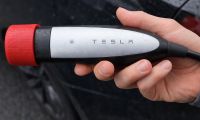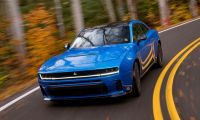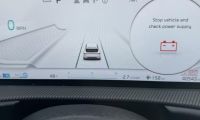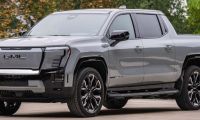The history of electric car advertising campaigns has a spotty record, for example the early Nissan Leaf commercial about hugging a polar bear. Nissan just released a new commercial, released yesterday, that is part of a "WHAT IF" global advertising campaign, that asks a number of great leading questions the gist of which is "What if you could drive the future, today?"
The Nissan Leaf is, of course, Nissan's entry into the electric car market. It is a 4-5 passenger family sedan that's vaguely similar to the Nissan Versa, but was designed from the ground up as an electric car. It has great performance, can hit 90 miles/hr or more on the highway, and has a 72 mile highway speed driving range, or just shy of 100 miles at city speed. One of the best, but under-valued, is that the Leaf is capable of fast charging using the CHADEMO standard.
The ad shown on YouTube is apparently based in Australia but is billed as a "Global Brand Campaign" which makes one think there may be versions, shot for different countries, but using the same script.
The video shows a rapid fire sequence of typical life scenarios, while a narrator is asking "What If" questions. The tone of these questions circle around the Leaf as a piece of advanced technology, that is an example of the future of transportation.
An example is "What if you could check on your car, from your phone? And switch on the air conditioning, remotely?" While modern cars are starting to have smart phone apps to remotely manage the car, this feature is incredibly important for electric car owners, if only to remotely monitor the charging process and be assured of having a full charge when you go to your car. The ability to switch on the air conditioning remotely is not just a nice creature comfort, it is a strategy for getting more range out of the battery pack. By heating or cooling the car while it is plugged in to a charger, the passenger cabin is put at a comfortable temperature without using power from the battery pack.
"What if you could drive with zero emissions?" While gasoline cars are getting cleaner every year, there is no way to burn gasoline or diesel with zero emissions, nor is there a way to extract petroleum from the ground and refine it into gasoline without emitting a bunch of toxic chemicals. An electric car does away with those concerns, at the tailpipe. If you go further upstream to the electrical power plant, we see that the electrical grid is getting cleaner every year while a gasoline car gets dirtier every year as its engine ages. Why does the grid get cleaner? One reason is there is a shift underway where coal is becoming less popular, and natural gas is becoming more popular, according to a report from the Dept of Energy, Energy Information Agency, titled Monthly Energy Review for September 2012. This by itself will change the environmental impact of generating electricity.
"What if you could top up your car during your lunch break?" If, or rather when, electric car charging infrastructure is widely enough spread, you will be able to recharge an electric car anywhere you go. Thus, for lunch you could pop over to any restaurant, plug in and charge while eating lunch, and even top up the battery pack. Generally speaking, while electric car recharge times can seem long, your personal involvement is only the 30 seconds or less it takes to plug in to the charging station. Generally you'll be elsewhere doing something else while the car is charging and that recharge time does not actually consume your personal time.
"What if, one day, it could power your house?" At that point the video shows the car owner driving into their garage, and plugging a CHADEMO cord into the quick charge port. The CHADEMO is designed for bi-directional electricity flow meaning that it can not only be used to recharge the car, but that electricity can be drawn out of the car and used on the electrical grid. In this advertisement this is presented as a way to power your house, but it's not quite a good idea to do so on a routine basis. The energy stored in an electric car has to come from somewhere, because the car does not have its own generator.
Where the bi-directional electricity flow is expected to play a significant role is in the "Smart Grid". The vision is that when there are millions of electric cars in use, a large number will be plugged into charging stations for a large part of the day, but not necessarily charging the whole time. Instead the charging stations will be bi-directional, and the Smart Grid will be able to borrow electricity from cars in the case of impending brownouts. The powers-that-be see a parking lot full of idle electric cars as a potentially huge grid energy storage system that could, with the right incentives and charging protocols, serve as a huge standby power source to stabilize the grid during peak demand times.












Comments
Good ad but I'd still like to
Permalink
Good ad but I'd still like to see Nissan highlight the fuel cost for an average week of commuting.